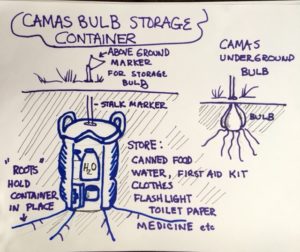Problem:
Long-term food and clothing storage for emergencies and disasters.
Biomimicry Idea:
A Camas plant is divided into two general sections: the underground bulb, and the above ground shoot. The bulb is similar to a potato in that it stores high amounts of carbohydrates. When camas is hampered, the above ground shoot wilts and the energy it contained runs down into the underground bulb to ensure its long-term survival through harsh conditions. During harsh conditions, the shoot no longer grows, nor does it receive support from the bulb, but it still maintains its pre-formed structure the same way a decaying tree will remain standing despite its loss of vigor. These above ground shoots served as markers for Camas gatherers like the Multnomah Indians on Sauvie Island.
Mimic Camas :
Using Camas as a biomimicry example, we could build emergency supply underground storage bins. These are underground containers, spread evenly throughout level-grounded areas with shoot-like rods projecting from the container through the ground and out into the surface. This would mark the site of the underground container . Just like a camas bulb that stores nutrients for the plant, each container will store emergency supplies like water, first aid, and canned food. Others may have clothing, and survival equipment.

The Multnomah, part of the Chinook tribe, historically lived on and near Sauvie Island. One of the many ways that they provided for themselves was by harvesting camas, a perennial herb in the lily family, often found from April to June. The camas bulb is high in nutritional value. It was dug up historically with special digging sticks made of Yew and antler. To ensure sustainability and increased numbers of camas this plant is harvested by dividing the bulbs and replanting the small bulbs in in the ground, taking large bulbs for food and leaving small bulbs to grow large. Fires were often set to keep the land open and suitable for camas fields. By harvesting and managing in this way, Native people today as well as historically, honor their ancestors and future generations by ensuring the health and success of camas patches
Source: Shawash Kakwe Presentation by David Harrelson, Tribal Historic Preservation Officer of the Confederated Tribes of Grand Rhond
